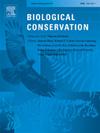Putting earthworm conservation on the map: Shortfalls and solutions for developing earthworm conservation
IF 4.9
1区 环境科学与生态学
Q1 BIODIVERSITY CONSERVATION
引用次数: 0
Abstract
Earthworms are keystone organisms that influence both soil function and community assembly of other soil organisms. However, soils are increasingly threatened by global change, so there is an urgent need to consider earthworms in conservation strategies. Earthworm monitoring has been promoted in numerous European and country research programs, and the global interest in earthworm conservation is rising, resulting in a rapid increase in the availability of earthworm data. However, most research focuses on a limited number of local-scale indicators, mainly based on abundance, biomass, and species richness of assemblages along with Bouché's ecological categories. We argue that these metrics are insufficient to effectively address earthworm conservation issues. We suggest four ecological characteristics which may be more informative for the development of conservation plans. Measurement of how much a species is (i) rare or common, (ii) native/nonnative, endemic and invasive, (iii) a specialist or generalist, and (iv) a winner or loser in the Anthropocene are all promising tools to support earthworm diversity conservation. These metrics could also be applied to functional traits, but better definition of these traits is fundamental. Finally, we emphasize the need to broaden spatial scales in earthworm studies by analyzing alpha, beta and gamma components of diversity, as local diversity alone can be misleading.
求助全文
约1分钟内获得全文
求助全文
来源期刊

Biological Conservation
环境科学-环境科学
CiteScore
10.20
自引率
3.40%
发文量
295
审稿时长
61 days
期刊介绍:
Biological Conservation is an international leading journal in the discipline of conservation biology. The journal publishes articles spanning a diverse range of fields that contribute to the biological, sociological, and economic dimensions of conservation and natural resource management. The primary aim of Biological Conservation is the publication of high-quality papers that advance the science and practice of conservation, or which demonstrate the application of conservation principles for natural resource management and policy. Therefore it will be of interest to a broad international readership.
 求助内容:
求助内容: 应助结果提醒方式:
应助结果提醒方式:


